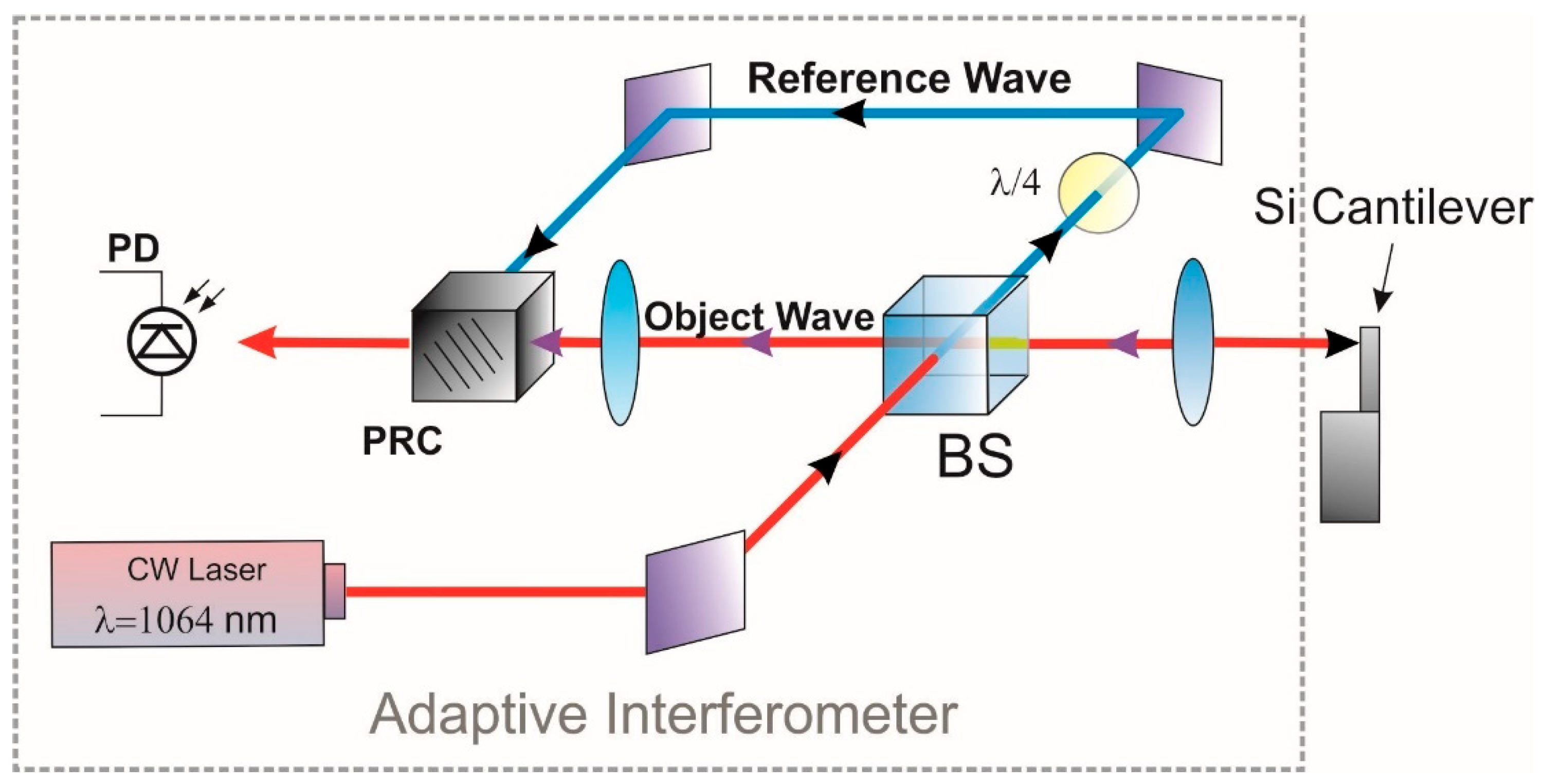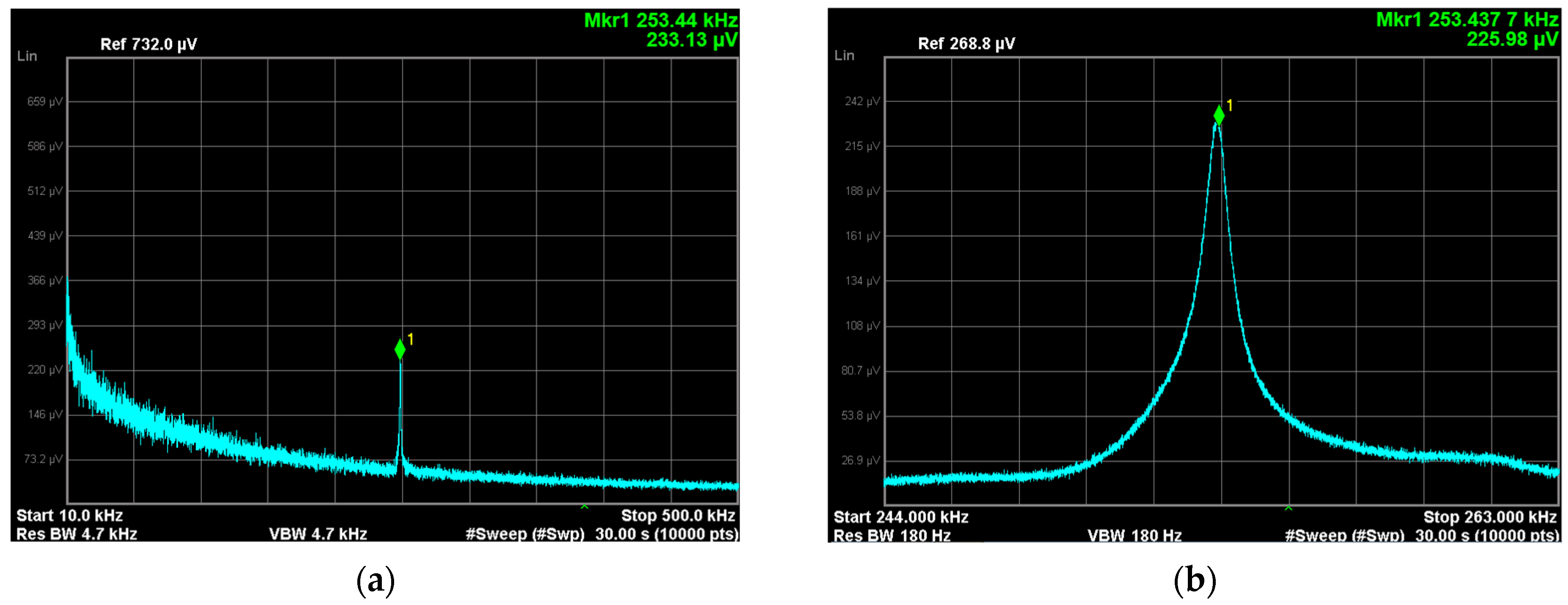Micro-Weighing Based Biosensor with Adaptive Interferometry †
Abstract
:1. Introduction
2. Experimental Setup and Methods
3. Experimental Results
4. Conclusions
Author Contributions
Funding
Institutional Review Board Statement
Informed Consent Statement
Data Availability Statement
Conflicts of Interest
References
- Burg, T.P.; Scott, R.M. Suspended microchannel resonators for biomolecular detection. Appl. Phys. Lett. 2003, 83, 2698–2700. [Google Scholar] [CrossRef]
- Kravets, V.G.; Kabashin, A.V.; Barnes, W.L.; Grigorenko, A.N. Plasmonic surface lattice resonances: A review of properties and applications. Chem. Rev. 2018, 118, 5912–5951. [Google Scholar] [CrossRef] [PubMed]
- Mondal, B.; Ramlal, S.; Lavu, P.S.; Kingston, J. Highly sensitive colorimetric biosensor for staphylococcal enterotoxin B by a label-free aptamer and gold nanoparticles. Front. Microbiol. 2018, 9, 179. [Google Scholar] [CrossRef] [PubMed]
- Tran, D.P.; Pham, T.T.T.; Wolfrum, B.; Offenhausser, A.; Thierry, B. CMOS-compatible silicon nanowire field-effect transistor biosensor: Technology development toward commercialization. Materials 2018, 11, 785. [Google Scholar] [CrossRef] [PubMed]
- Kalra, S. Implantable Bio-MEMS applications: A review. In Proceedings of the 2017 Recent Developments in Control, Automation & Power Engineering (RDCAPE), Noida, India, 26–27 October 2017; pp. 131–136. [Google Scholar]
- Ilic, B.; Craighead, H.G.; Krylov, S.; Senaratne, W.; Ober, C.; Neuzil, P. Attogram detection using nanoelectromechanical oscillators. J. Appl. Phys. 2004, 95, 3694–3703. [Google Scholar] [CrossRef]
- Kamshilin, A.A.; Romashko, R.V.; Kulchin, Y.N. Adaptive interferometry with photorefractive crystals. J. Appl. Phys. 2009, 105, 1. [Google Scholar] [CrossRef]
- Romashko, R.V.; Efimov, T.A.; Kulchin, Y.N. Resonance micro-weighing of sub-picogram mass with the use of adaptive interferometer. Meas. Sci. Rev. 2014, 14, 160–163. [Google Scholar] [CrossRef]
- Efimov, T.A.; Rassolov, E.A.; Andryukov, B.G.; Zaporozhets, T.S.; Romashko, R.V. Calculation of Resonant Frequencies of Silicon AFM Cantilevers. J. Phys. Conf. Ser. 2020, 1439, 012006. [Google Scholar] [CrossRef]


Disclaimer/Publisher’s Note: The statements, opinions and data contained in all publications are solely those of the individual author(s) and contributor(s) and not of MDPI and/or the editor(s). MDPI and/or the editor(s) disclaim responsibility for any injury to people or property resulting from any ideas, methods, instructions or products referred to in the content. |
© 2023 by the authors. Licensee MDPI, Basel, Switzerland. This article is an open access article distributed under the terms and conditions of the Creative Commons Attribution (CC BY) license (https://creativecommons.org/licenses/by/4.0/).
Share and Cite
Efimov, T.; Kumeiko, V.; Romashko, R.; Shmelev, M.; Rassolov, E. Micro-Weighing Based Biosensor with Adaptive Interferometry. Eng. Proc. 2023, 35, 10. https://doi.org/10.3390/IECB2023-14570
Efimov T, Kumeiko V, Romashko R, Shmelev M, Rassolov E. Micro-Weighing Based Biosensor with Adaptive Interferometry. Engineering Proceedings. 2023; 35(1):10. https://doi.org/10.3390/IECB2023-14570
Chicago/Turabian StyleEfimov, Timofey, Vadim Kumeiko, Roman Romashko, Mikhail Shmelev, and Evgeni Rassolov. 2023. "Micro-Weighing Based Biosensor with Adaptive Interferometry" Engineering Proceedings 35, no. 1: 10. https://doi.org/10.3390/IECB2023-14570






